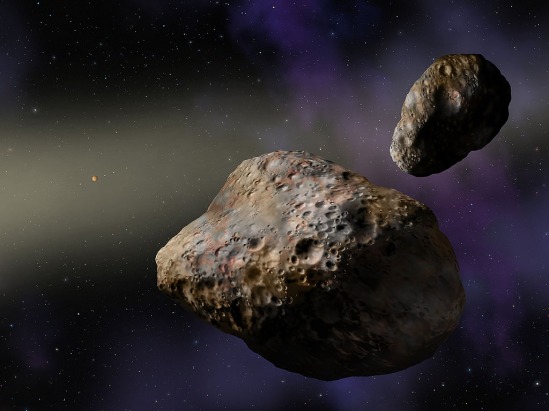CAPE CANAVERAL, Fla (Reuters) – A huge asteroid will pass closer to Earth than the moon on Tuesday, giving scientists a rare chance for study without having to go through the time and expense of launching a probe, officials said.
Earth’s close encounter with Asteroid 2005 YU 55 will occur at 6:28 p.m. EST (10:28 p.m. BT) on Tuesday, as the space rock sails about 201,000 miles (323,469 km) from the planet.
“It is the first time since 1976 that an object of this size has passed this closely to the Earth. It gives us a great — and rare — chance to study a near-Earth object like this,” astronomer Scott Fisher, a program director with the National Science Foundation, said on Friday during a Web chat with reporters.
The orbit and position of the asteroid, which is about 1,312 feet (400 meters) in diameter, is well known, added senior research scientist Don Yeomans, with NASA’s Jet Propulsion Laboratory in Pasadena, California.
“There is no chance that this object will collide with the Earth or moon,” Yeomans said.
Thousands of amateur and professional astronomers are expected to track YU 55’s approach, which will be visible from the planet’s northern hemisphere. It will be too dim to be seen with the naked eye, however, and it will be moving too fast for viewing by the Hubble Space Telescope.
“The best time to observe it would be in the early evening on November 8 from the East Coast of the United States,” Yeomans said. “It is going to be very faint, even at its closest approach. You will need a decent-sized telescope to be able to actually see the object as it flies by.”
Scientists suspect YU 55 has been visiting Earth for thousands of years, but because gravitational tugs from the planets occasionally tweak its path, they cannot tell for sure how long the asteroid has been in its present orbit.
“These sorts of events have been happening for most of the lifetime of the Earth, about 4.5 billion years,” Fisher said.
Computer models showing the asteroid’s path for the next 100 years show there is no chance it will hit Earth during that time, added Yeomans.
“We do not think that it will ever impact the Earth or moon (but) we only have its orbit calculated for the next 100 years,” he said.
Previous studies show the asteroid, which is blacker than charcoal, is what is called a C-type asteroid that is likely made of carbon-based materials and some silicate rock.
More information about its composition and structure are expected from radar images and chemical studies of its light as the asteroid passes by the planet.
“I’ve read that we will be able to see details down to a size of about 15 feet (4.5 meters) across on the surface of the asteroid,” Fisher said.
NASA is working on a mission to return soil samples from an asteroid known as 1999 RQ36 in 2020, followed by a human mission to another asteroid in the mid-2020s.
Japan also plans to launch an asteroid sample return mission in 2018.
(Editing by Tom Brown and Philip Barbara)
The bad news first: An asteroid the size of an aircraft carrier will be hurtling toward Earth and is expected to fly between the Earth and the moon on Tuesday. The good news: The space rock will not, repeat not, hit Earth. Even though NASA has classified asteroid 2005 YU55 as a “potentially hazardous object.” Even though it will pass closer than all other large asteroids have done in the past 35 years. It will do just that: pass by.
But the 1,300-foot-wide object, which will be just 201,700 miles away from Earth, offers a rare scientific opportunity. “Asteroids have passed this close or even closer in the past, but astronomers have not had as much advance notice,” noted Bing Quock, assistant director of the Morrison Planetarium at the California Academy of Sciences, in an email to Yahoo! News.
Quock added that the early alert, coupled with the asteroid’s proximity to Earth, will allow NASA to map the surface of this particular asteroid “to quite a spectacular resolution that’s usually available only by sending spacecraft up close to the object.” The last time an asteroid flew this close to Earth was in 1976. The next time won’t be until 2028.
To get a good read of the huge space rock, scientists at NASA will engage a 230-foot-long antenna out of the Deep Space Network in Goldstone, California. The giant Arecibo radio telescope in Puerto Rico will also capture images of the asteroid, starting at 3:28 p.m. PT on November 8.
Fun fact for amateur astronomers: The asteroid is actually moving too fast for the Hubble Space Telescope, but, according to CNN, you could spot it with a telescope of at least 6 inches in diameter. Track the asteroid here.
Space fans are keeping tabs on “asteroid 2005 YU55” on the Web: Searches on the term rose to the stratosphere in just one day. Popular lookups also included “asteroid November 8 2011,” “near earth asteroid 2011,” and “asteroid near misses.” For the record, there have been a few asteroids that have come close — in planetary terms — to Earth. A bus-sized asteroid narrowly missed the planet back in June.


